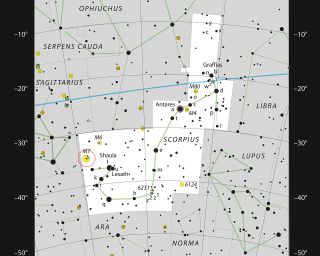Stars Sparkle Like Diamonds in Space Scorpion Tail (Photo, Video)
Brilliant stars shine like dusty diamonds in the tail of a cosmic scorpion in a dazzling new image and video captured by a telescope in Chile.
The new photo, taken by astronomers with the European Southern Observatory in Chile's Atacama Desert, shows the stars of Messier 7 (M7), a star cluster so bright that it can be seen with the naked eye. The cluster is about 800 light-years away in the tail of the constellation Scorpius (The Scorpion), and is one of the prominent ones in Earth's sky, ESO scientists said. The researchers used the ESO telescope observations to create a stunning video tour of the M7 star cluster, which Space.com set to the song "I Wonder" by the band Super 400.
"An interesting feature in this image is that, although densely populated with stars, the background is not uniform and is noticeably streaked with dust. This is most likely to be just a chance alignment of the cluster and the dust clouds," ESO officials wrote in a photo description. [Amazing Celestial Photos of ESO's Paranal Telescope]
"Although it is tempting to speculate that these dark shreds are the remnants of the cloud from which the cluster formed, the Milky Way will have made nearly one full rotation during the life of this star cluster, with a lot of reorganization of the stars and dust as a result."

The new ESO picture of M7 (also called NGC 6475) was snapped with the MPG/ESO 2.2-meter telescope at La Silla Observatory in Chile.
Open clusters such as this one show stars that were born at about the same time and location from a gas and dust cloud. M7 itself was born about 200 million years ago, and it's expected that about a tenth of the cluster's star population will ultimately explode and die as supernovas.
The first known observation of M7 was described around 130 AD by astronomer Claudius Ptolemy, who called it a "nebula following the sting of Scorpius."
Sign up for the Live Science daily newsletter now
Get the world’s most fascinating discoveries delivered straight to your inbox.
For more information on the music of Super 400 used by Space.com in the new video, visit: www.super400.com.
Follow Elizabeth Howell @howellspace, or Space.com @Spacedotcom. We're also on Facebook and Google+. Original article on Space.com.

Elizabeth Howell was staff reporter at Space.com between 2022 and 2024 and a regular contributor to Live Science and Space.com between 2012 and 2022. Elizabeth's reporting includes multiple exclusives with the White House, speaking several times with the International Space Station, witnessing five human spaceflight launches on two continents, flying parabolic, working inside a spacesuit, and participating in a simulated Mars mission. Her latest book, "Why Am I Taller?" (ECW Press, 2022) is co-written with astronaut Dave Williams.












